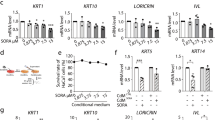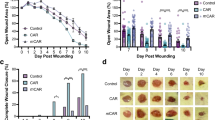Abstract
Neuropilin 1 (NRP1) is a co-receptor for vascular endothelial growth factor (VEGF165), an inducer of vascular permeability and angiogenesis. Numerous physiological factors enhance VEGF expression and function but only a few have been shown to be negative regulators. Previously, we have shown that the naturally occurring soluble form of NRP1 (sNRP1) inhibits binding of VEGF165 to endothelial cells in vitro and impairs tumor growth in vivo. To investigate the role of sNRP1 in the regulation of vascular development and function, sNRP1 expression was targeted to the skin, where it is not normally expressed, using a keratin 14 (K14) promoter expression construct. K14-sNRP1 transgenic mice displayed normal skin architecture with a subtle abnormal vascular phenotype. While the overall number of skin blood vessels remained unchanged, the lumen size of smooth muscle-associated dermal vessels was reduced. K14-sNRP1 mice had reduced vascular permeability in response to VEGF165, but also to VEGF121 and platelet activating factor, suggesting that the lack of permeability was not solely due to the sequestration of VEGF. sNRP1 also reversed the increase in inflammation and edema induced by transgenic VEGF overexpression in cutaneous delayed-type hypersensitivity reactions. In summary, sNRP1 appears to primarily regulate vessel permeability while its effect on physiological angiogenesis is less evident in this model.
Similar content being viewed by others
Abbreviations
- DTH:
-
delayed-type hypersensitivity
- EC:
-
endothelial cell
- EGF:
-
epidermal growth factor
- FGF:
-
fibroblast growth factor
- H&E:
-
hematoxylin and eosin
- HIF:
-
hypoxia inducible factor
- K1:
-
keratin 1
- K14:
-
keratin 14
- NRP1:
-
neuropilin 1
- PlGF:
-
placenta growth factor
- PAF:
-
platelet activating factor
- SMA:
-
smooth muscle actin
- sNRP1:
-
soluble neuropilin 1
- Tg:
-
transgenic
- TC:
-
trichrome
- VEGF/VPF:
-
vascular endothelial growth factor/vascular permeability factor
References
Fujisawa H, Kitsukawa T. (1998). Receptors for collapsin/semaphorins. Curr Opin Neurobiol 8:587–92
Kitsukawa T, Shimizu M, Sanbo M, et al. (1997). Neuropilin-semaphorin III/D-mediated chemorepulsive signals play a crucial role in peripheral nerve projection in mice. Neuron 19(5):995–1005
Kolodkin AL, Levengood DV, Rowe EG, et al. (1997). Neuropilin is a semaphorin III receptor. Cell 90(4):753–62
Soker S, Takashima S, Miao HQ, et al. (1998). Neuropilin-1 is expressed by endothelial and tumor cells as an isoform-specific receptor for vascular endothelial growth factor. Cell 92(6):735–45
Kawasaki T, Kitsukawa T, Bekku Y, et al. (1999). A requirement for neuropilin-1 in embryonic vessel formation. Dev Suppl 126(21):4895–902
Takashima S, Kitakaze M, Asakura M, et al. (2002). Targeting of both mouse neuropilin-1 and neuropilin-2 genes severely impairs developmental yolk sac and embryonic angiogenesis. Proc Natl Acad Sci U S A 99(6):3657–62
Ferrara N. (1999). Molecular and biological properties of vascular endothelial growth factor. J Mol Med 77:527–43
Feng D, Nagy JA, Pyne K, et al. (1999). Pathways of macromolecular extravasation across microvascular endothelium in response to VPF/VEGF and other vasoactive mediators. Microcirculation 6(1):23–44
Dvorak HF, Nagy JA, Feng D, et al. (1999). Vascular permeability factor/vascular endothelial growth factor and the significance of microvascular hyperpermeability in angiogenesis. Curr Top Microbiol Immunol 237:97–132
Cross MJ, Dixelius J, Matsumoto T, et al. (2003). VEGF-receptor signal transduction. Trends Biochem Sci 28(9):488–94
Gagnon ML, Bielenberg DR, Gechtman Z, et al. (2000). Identification of a natural soluble neuropilin-1 that binds vascular endothelial growth factor: In vivo expression and antitumor activity. Proc Natl Acad Sci USA 97(6):2573–8
Rossignol M, Gagnon ML, Klagsbrun M. (2000). Genomic organization of human neuropilin-1 and neuropilin-2 genes: Identification and distribution of splice variants and soluble isoforms. Genomics 70(2):211–22
Mamluk R, Gechtman Z, Kutcher ME, et al. (2002). Neuropilin-1 binds vascular endothelial growth factor 165, placenta growth factor-2, and heparin via its b1b2 domain. J Biol Chem 277(27):24818–25
Yamada Y, Takakura N, Yasue H, et al. (2001). Exogenous clustered neuropilin 1 enhances vasculogenesis and angiogenesis. Blood 97(6):1671–8
Kishimoto J, Ehama R, Ge Y, et al. (2000). In vivo detection of human vascular endothelial growth factor promoter activity in transgenic mouse skin. Am J Pathol 157(1):103–10
Detmar M, Yeo KT, Nagy JA, et al. (1995). Keratinocyte-derived vascular permeability factor (vascular endothelial growth factor) is a potent mitogen for dermal microvascular endothelial cells. J Invest Dermatol 105(1):44–50
Detmar M, Brown LF, Schon MP, et al. (1998). Increased microvascular density and enhanced leukocyte rolling and adhesion in the skin of VEGF transgenic mice. J Invest Dermatol 111(1):1–6
Bielenberg DR, McCarty MF, Bucana CD, et al. (1999). Expression of interferon-beta is associated with growth arrest of murine and human epidermal cells. J Invest Dermatol 112(5):802–9
Oura H, Bertoncini J, Velasco P, et al. (2003). A critical role of placental growth factor in the induction of inflammation and edema formation. Blood 101(2):560–7
Gad SC, Dunn BJ, Dobbs DW, et al. (1986). Development and validation of an alternative dermal sensitization test: The mouse ear swelling test (MEST). Toxicol Appl Pharmacol 84(1):93–114
Bates D, Taylor GI, Minichiello J, et al. (2003). Neurovascular congruence results from a shared patterning mechanism that utilizes Semaphorin3A and Neuropilin-1. Dev Biol 255(1):77–98
Detmar M, Brown LF, Claffey KP, et al. (1994). Overexpression of vascular permeability factor/vascular endothelial growth factor and its receptors in psoriasis. J Exp Med 180(3):1141–6
Vassar R, Rosenberg M, Ross S, et al. (1989). Tissue-specific and differentiation-specific expression of a human K14 keratin gene in transgenic mice. Proc Natl Acad Sci USA 86(5):1563–7
Larcher F, Murillas R, Bolontrade M, et al. (1998). VEGF/VPF overexpression in skin of transgenic mice induces angiogenesis, vascular hyperpermeability and accelerated tumor development. Oncogene 17(3):303–11
Kunstfeld R, Hirakawa S, Hong YK, et al. (2004). Induction of cutaneous delayed-type hypersensitivity reactions in VEGF-A transgenic mice results in chronic skin inflammation associated with persistent lymphatic hyperplasia. Blood 104(4):1048–57
Iliopoulos O, Levy AP, Jiang C, et al. (1996). Negative regulation of hypoxia-inducible genes by the von Hippel-Lindau protein. Proc Natl Acad Sci USA 93(20):10595–9
Fujisawa T, Watanabe J, Kamata Y, et al. (2003). Effect of p53 gene transfection on vascular endothelial growth factor expression in endometrial cancer cells. Exp Mol Pathol 74(3):276–81
Kendall RL, Thomas KA. (1993). Inhibition of vascular endothelial cell growth factor activity by an endogenously encoded soluble receptor. Proc Natl Acad Sci USA 90(22):10705–9
Roeckl W, Hecht D, Sztajer H, et al. (1998). Differential binding characteristics and cellular inhibition by soluble VEGF receptors 1 and 2. Exp Cell Res 241(1):161–70
Takahashi T, Fournier A, Nakamura F, et al. (1999). Plexin-neuropilin-1 complexes form functional semaphorin-3A receptors. Cell 99(1):59–69
Fuh G, Garcia KC, de Vos AM. (2000). The interaction of neuropilin-1 with vascular endothelial growth factor and its receptor flt-1. J Biol Chem 275(35):26690–5
Byrne C, Tainsky M, Fuchs E. (1994). Programming gene expression in developing epidermis. Development 120(9):2369–83
Schuch G, Machluf M, Bartsch G Jr., et al. (2002). In vivo administration of vascular endothelial growth factor (VEGF) and its antagonist, soluble neuropilin-1, predicts a role of VEGF in the progression of acute myeloid leukemia in vivo. Blood 100(13):4622–8
Streit M, Velasco P, Riccardi L, et al. (2000) Thrombospondin-1 suppresses wound healing and granulation tissue formation in the skin of transgenic mice. Embo J 19(13):3272–82
Ruhrberg C, Gerhardt H, Golding M, et al. (2002). Spatially restricted patterning cues provided by heparin-binding VEGF-A control blood vessel branching morphogenesis. Genes Dev 16(20):2684–98
Carmeliet P, Ng YS, Nuyens D, et al. (1999). Impaired myocardial angiogenesis and ischemic cardiomyopathy in mice lacking the vascular endothelial growth factor isoforms VEGF164 and VEGF188. Nat Med 5(5):495–502
Detmar M. (2004). Evidence for vascular endothelial growth factor (VEGF) as a modifier gene in psoriasis. J Invest Dermatol 122:xiv
Acknowledgements
This work was supported by NIH grants CA37392 and CA45548 and the Harvard Skin Disease Research Center (M.K.), NIH grants CA69184, CA86410 and CA92644 (M.D.), a grant from the Ernst Schering Research Foundation in Berlin, Germany (R.M.), and the George & Elizabeth Sanborn Foundation Fellowship through the American Cancer Society (D.R.B.). The authors thank Drs. Elazar Zelzer and Nava Almog for helpful discussions and critical reading of the manuscript. We also thank Ricky Sanchez, Hetty Eisenberg, Lauren Janes, Paula Velasco, and Lin Wu for technical assistance and Kristen Gullage for photography and graphic design.
Author information
Authors and Affiliations
Corresponding author
Rights and permissions
About this article
Cite this article
Mamluk, R., Klagsbrun, M., Detmar, M. et al. Soluble neuropilin targeted to the skin inhibits vascular permeability. Angiogenesis 8, 217–227 (2005). https://doi.org/10.1007/s10456-005-9009-6
Received:
Revised:
Accepted:
Published:
Issue Date:
DOI: https://doi.org/10.1007/s10456-005-9009-6




